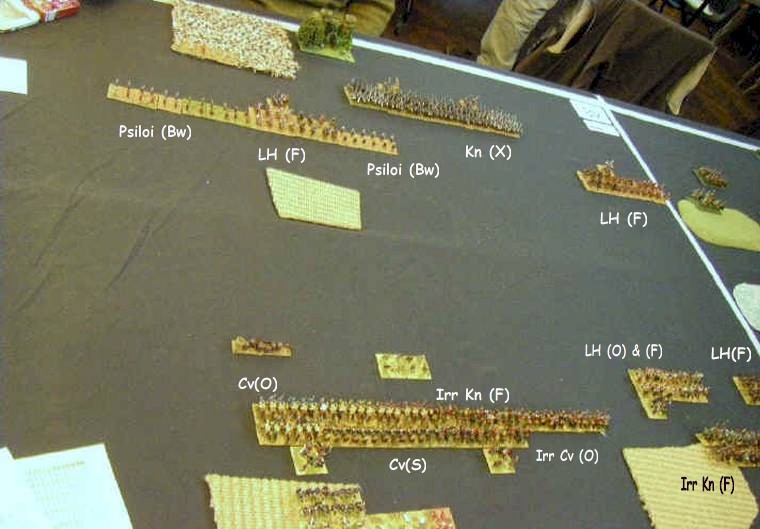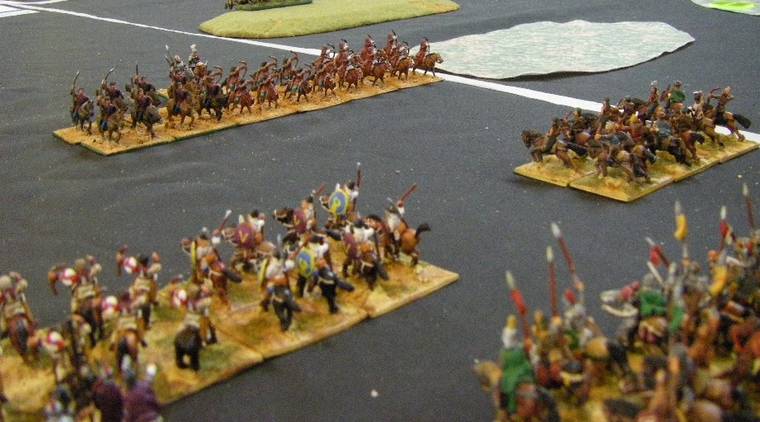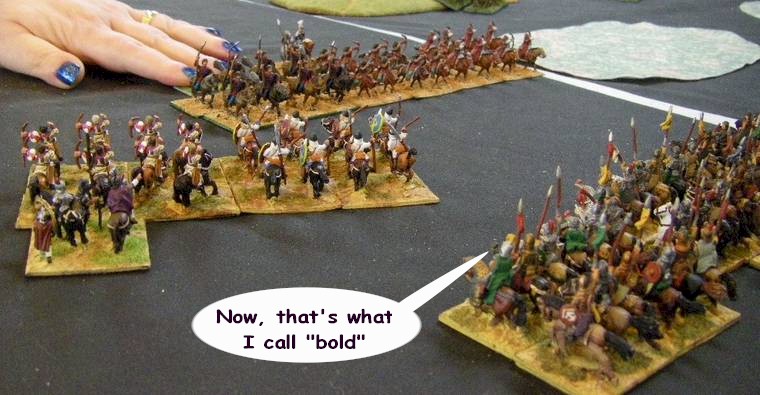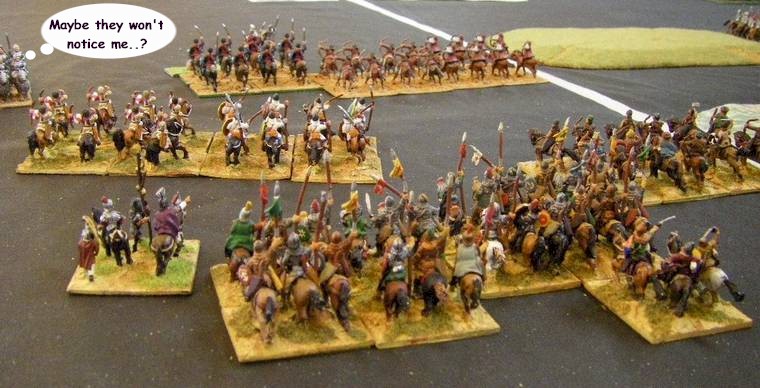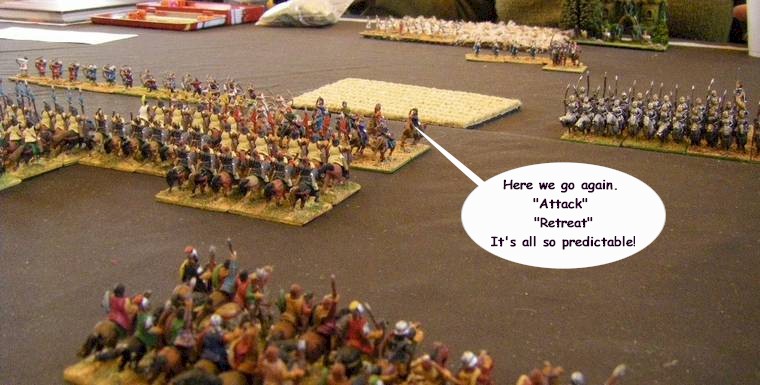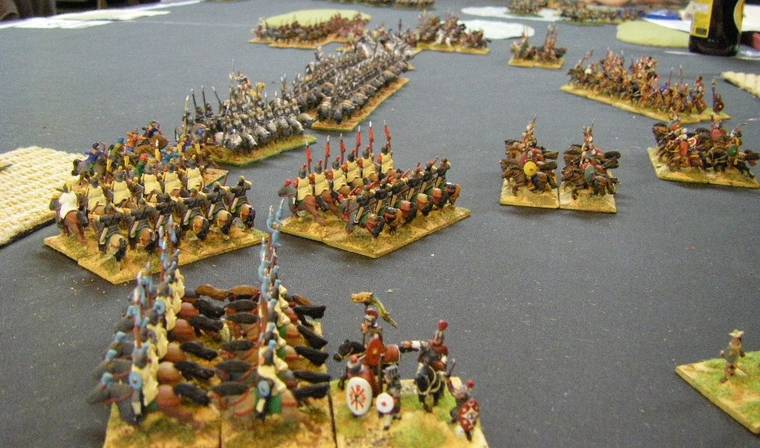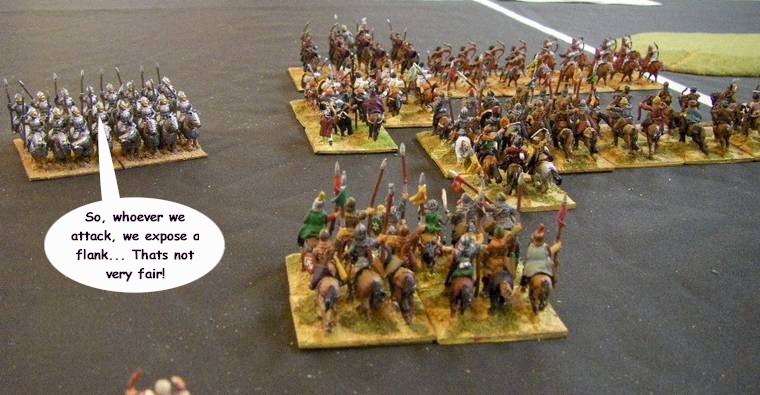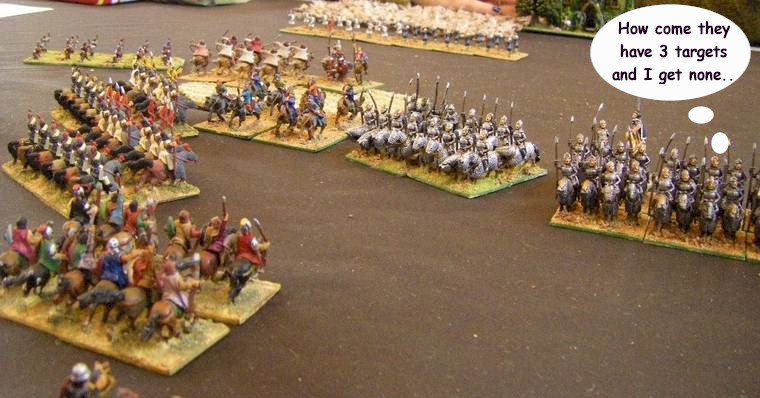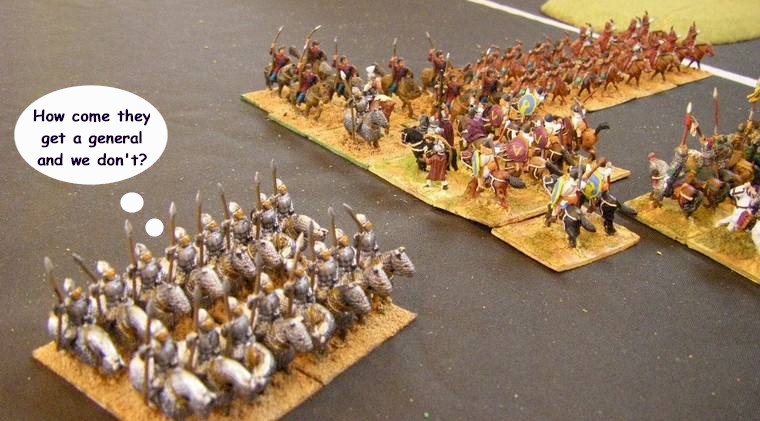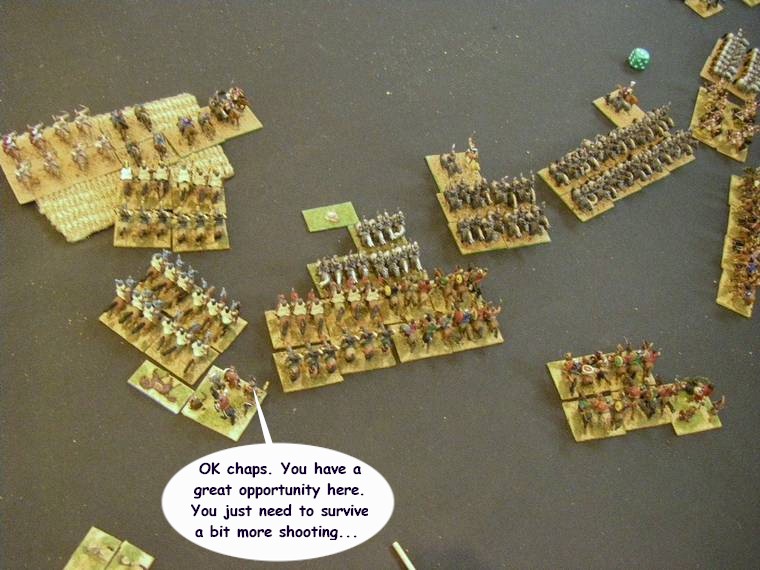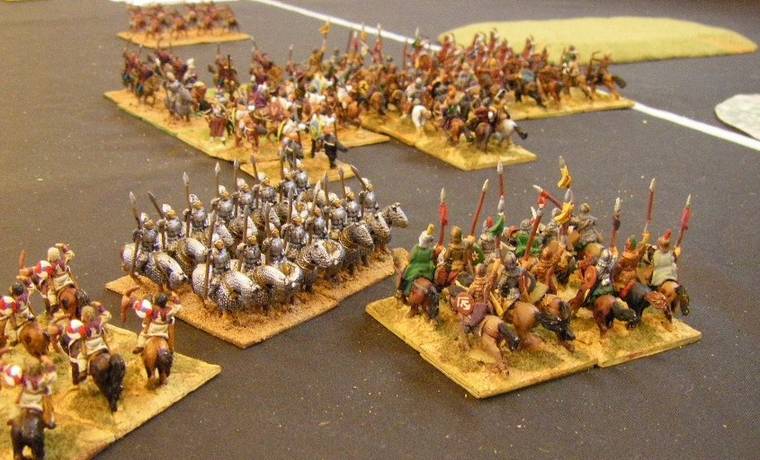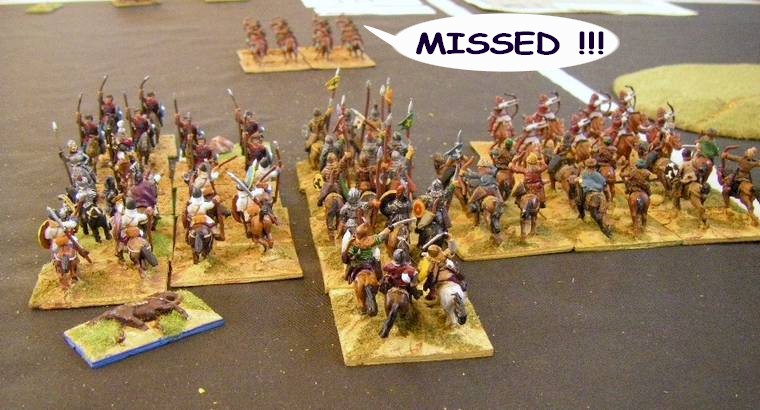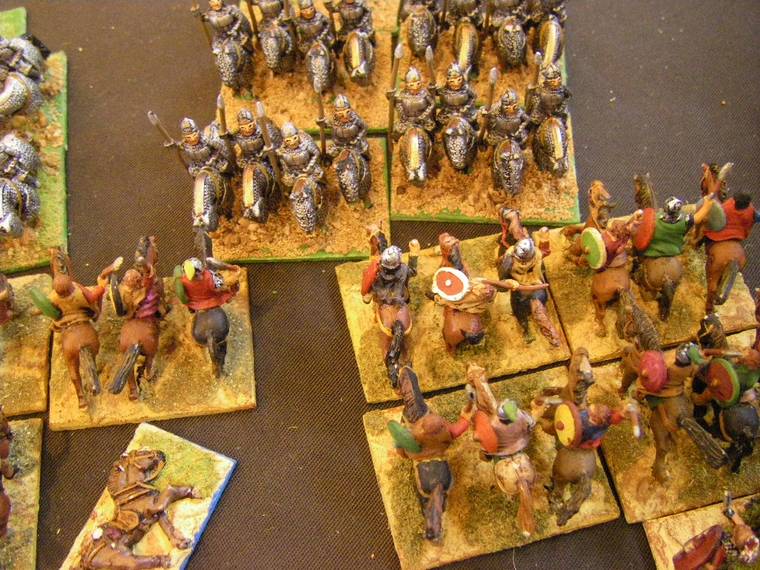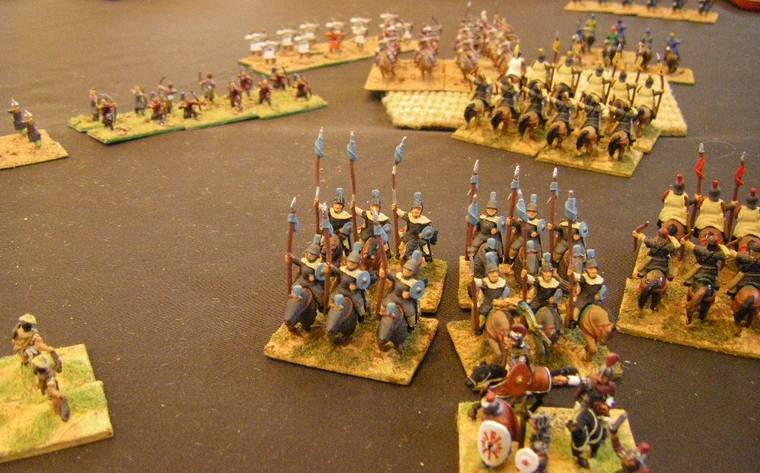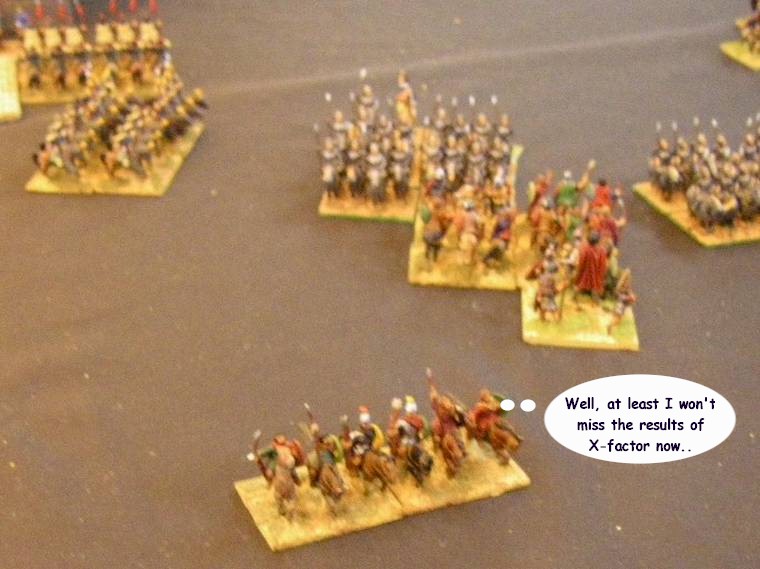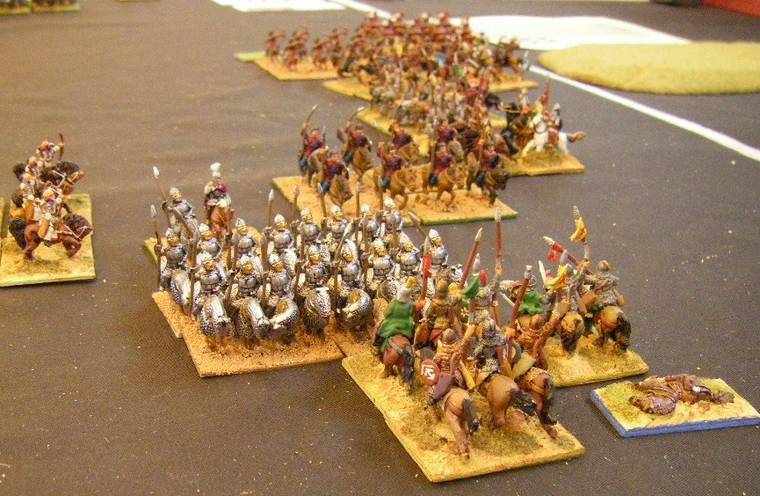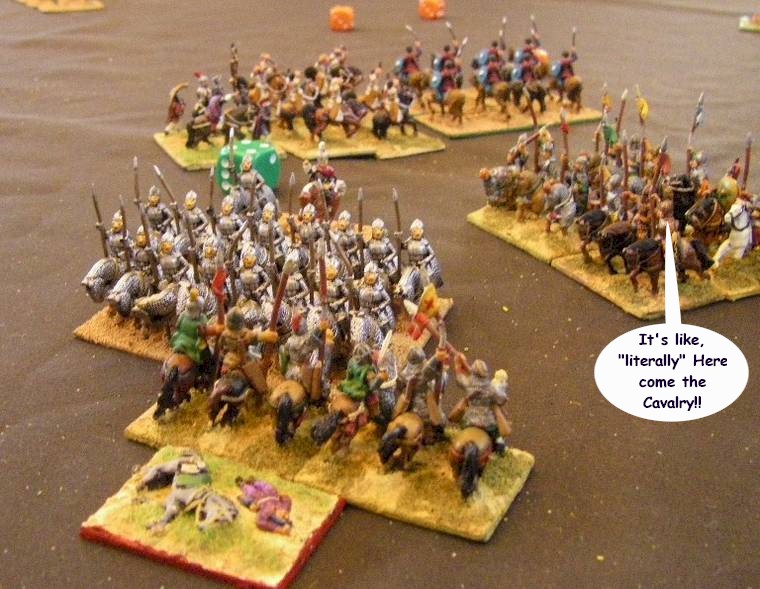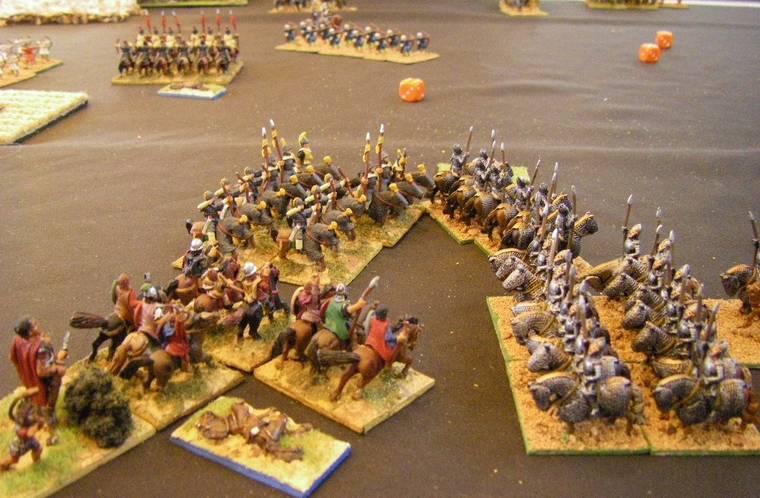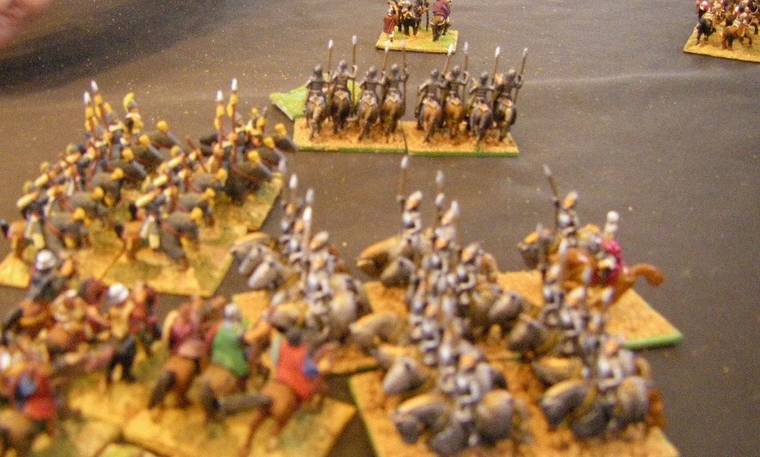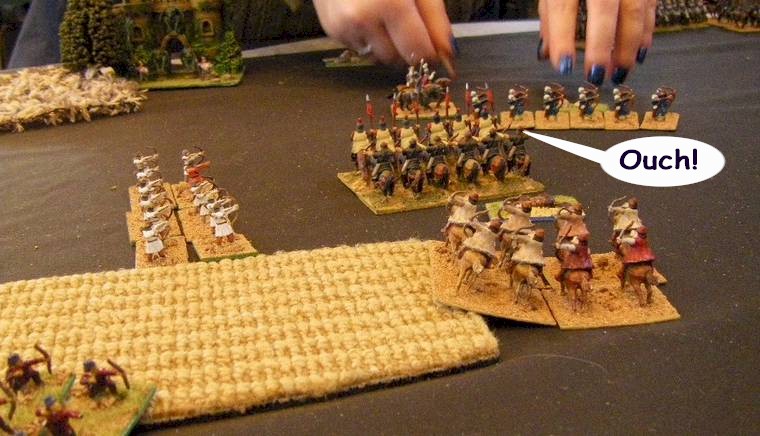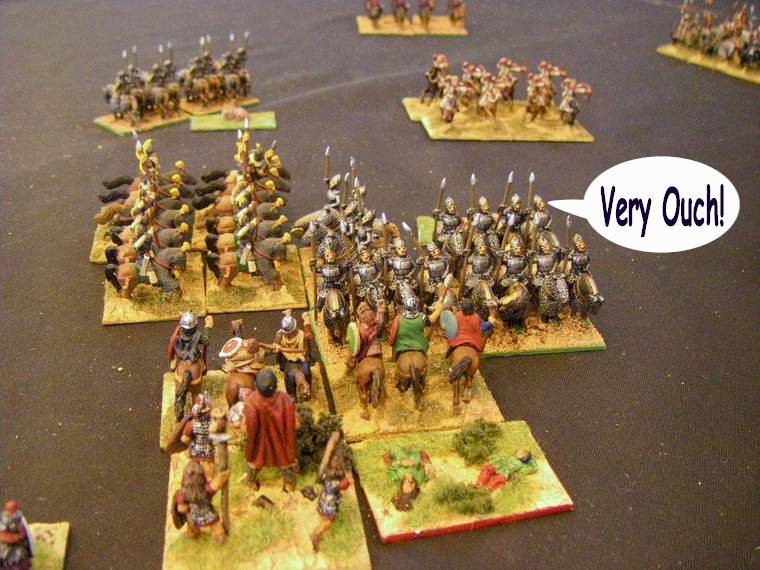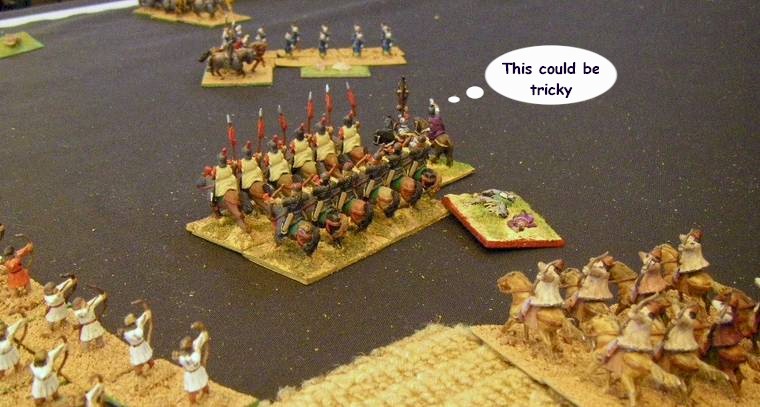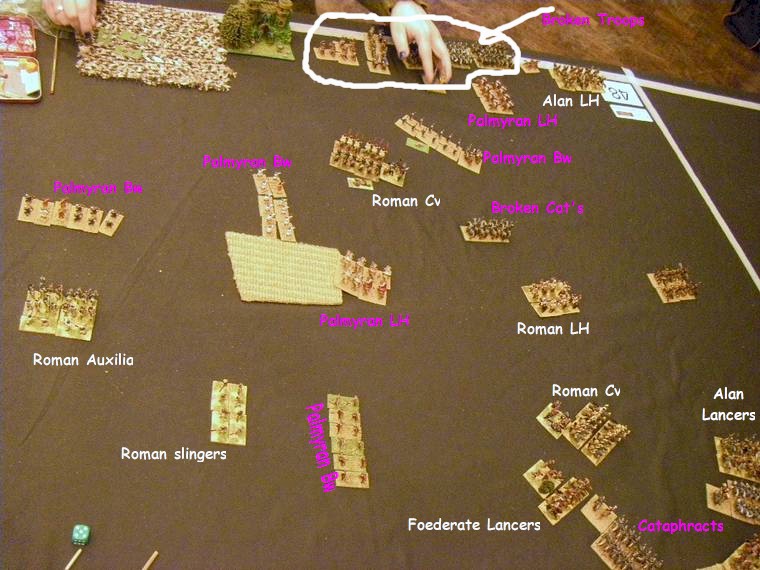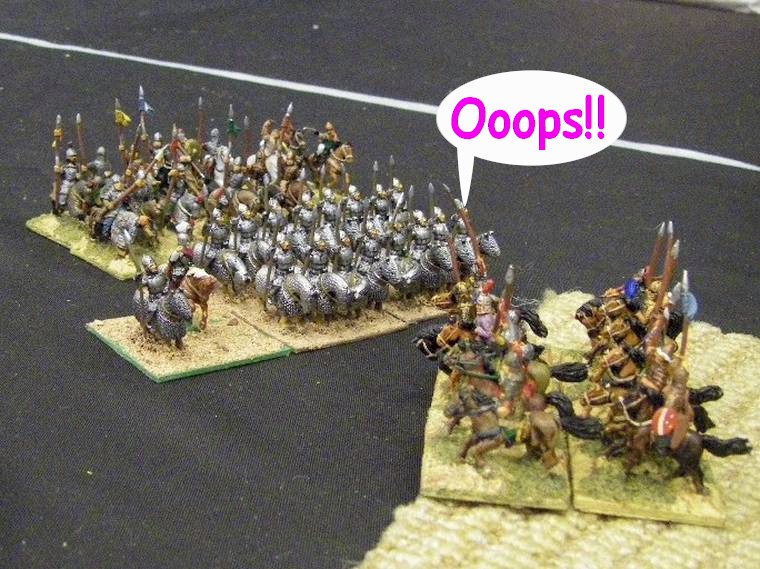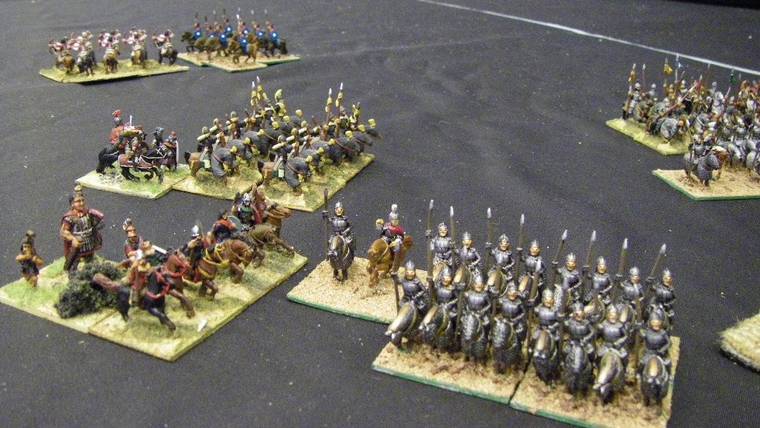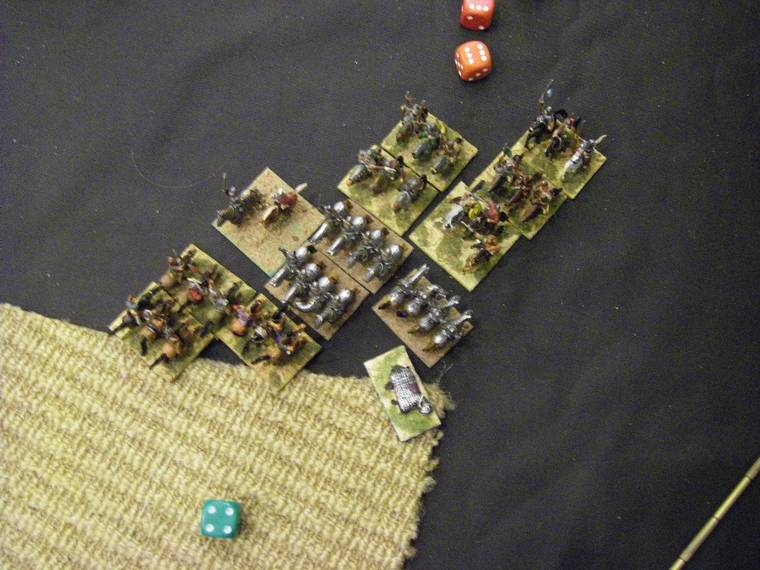Field of Glory Wargaming at Roll Call 2008
So, 2 defeats, one win - what next?
After braving the parking and traffic in Wycombe on Sunday lunchtime I found myself facing even more cataphracts - this time another Palmyran.
So maybe this time I could nick another win ? Or maybe not, given my learning experience from the previous game amounted to "you need a different army matey"
You can see the list and find out all about the Palmyrans here
Pictures of Late Roman Troops from my Ancients Photo Directory
 |
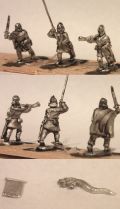 |
This time the terrain had been even less useful, although I had secured one of the magic uneven fields in the middle of the table.
This flavour of Palmyrans had stacks more light infantry than the previous version, and less cataphracts - however it had still massed some of its own light horse on its left wing, and the balance of the army was skewed left.
The Romans responded by massing their Alan allied command and all their light horse on the left also, hoping both to open up a flank of the cataphracts and also maybe even force the light horse wing back and catch a few fleeing units with a combination of lancers and light horse. This left 6 units in the middle to try and pick apart the 6 cataphract units facing them....
The Palmyrans were surprised by the loading of the Roman right wing, and their light horse looked in trouble from the off.. This time the Palmyran light horse skirmish screen's commander had to seriously think about changing his name from General Deja-Vu. to Sergeant Surprised.
The Cataphracts had a fairly unimpeded field across which to advance, but they remained carefully outside the uneven ground as they advanced, screened on their right flank by a horde of light troops.
Soon the Romans and Alans were ganging up on the Palmyran left wing - but with Poor horse archers shooting, the Roman missile fire proved rather ineffective.
Even though they stood up well to the bowmen, the Palmyran light horse still
didn't fancy taking on the Alan lancers, and so retreated to a safe distance to
await the arrival of the cataphracts. The Alans were getting tangled up in their
own light horse as they sought to push on to turn the Cataphracts flanks..
In the middle the bow-armed armoured Roman cavalry moved up boldly to try and take the patch of uneven ground
to command the Palmyrans right flank, relying on their lance-armed colleagues to
sweep away the light infantry bowmen to their left.
It all looked like the beginnings of a classic envelopment, but in the middle the cataphract line continued to advance, barely breaking sweat - was there something they knew that the Romans didn't ?
As the Alans sought to disentangle themselves from their own light horse, the wall of steel started to unpeel and the cataphracts allocated a unit to deal with the impertinent Alans. Would they be able to sweep away the Palmyran light horse quicker than the Palmyran Cataphracts could turn ?
On my left, the Armoured bowmen were struggling to persuade the Palmyran light horse that discretion was the better part of valor, as the slight disordering effect of the uneven ground reduced their shooting enough to keep the Palmyrans safe. But in any case, the Palmyran line was peeling off units as this end as well, and a lone cataphract unit turned out to face the threat of the Roman flankers.
This time the combination charge worked properly, and the Romans managed to create a 2:1 advantage against the first set of Cats - and the "yellow" unit of armoured bowmen was still roaming free as well!
With the prospect of imminent support arriving from the Alan lancers, the Roman javelin-armed horsemen decided to charge home - and, reluctant to let the Alans get behind their cataphracts, the Palmyran light horse resolved to stand! 2 generals committed to a LH vs LH battle - Yoiks!
Still unhappy with the height advantage of being a 28mm figure in a 15mm game, the Roman General jumped into his helicopter to gain an even clearer overview of the battlefield - and he was pleased with what he saw. Cats engaged at 2:1 odds - 2 "killer" units starting to turn round the flank to the right - the Cataphract line starting to fragment but largely chasing shadows - a strong push on the left as well.
OK, the "right hook" needed to sweep away some skirmishers to execute properly - and one unit was disrupted, but surely no fundamental problems there...?
Back to the left and as one unit of Alans failed to avoid the oncoming cataphracts, the other Alan lancers piled forward out of control at the prospect of hitting enemy light horse...
who promptly evaded, leaving the Alans looking rather foolish in the middle of a battle line of less capable troops doing all the fighting themselves.
In the middle the more Palmyran cataphracts were arriving on the scene - like London buses, they had all turned up at once. Again a unit of Foederate cavalry decided that an intercept charge was required, and just managed to get far enough forward to prevent the onrushing lancers hitting their already engaged (and fragmented, and rather battered) colleagues. This time it had worked in my favour! It was all going OK...
Oh No !!!!
But on the left things were not so hot. Despite the presence of a general, the average quality Roman lancers were highly discomforted by the barrage of shooting coming from the Palmyran skirmishers, and after a few rounds of damage, turned tail and fled! The Roman flank attack was looking threadbare all of a sudden...
But, threadbare or not, the "Yellow" lancers still managed to get in a charge on the embattled cataphracts holding up the end of the Palmyran line - and in a traumatic sequence of combats, the Palmyrans broke - but so did the Roman Foederate cavalry facing them!! Was this good or bad - who knew??
The two units of Alans continued to fail to link up - those fighting were struggling manfully to hold on long enough for their comrades in arms to rejoin them - but even with their general spurring them on, the potential flank chargers were reluctant to leave the chase and turned around painfully slowly. By the time they arrived to save the day, the day might be lost!!
With the Roman left flank basically now consisting of 2 units of cavalry, the
Palmyran infantry became very bold - especially after breaking the Roman lancers
by shooting alone. The Romans, desperate to absorb some shooting casualties
anywhere other than with their cavalry, resorted to the last-ditch approach of
moving up their Poor auxilia and slingers !
Swinging straight back to the other flank, the Alans were looking like they may just hang on - down to 50% losses, and Fragmented, they dug in as their colleagues teed themselves up for a devastating rear charge on the Cataphracts !
Back in the center, the "Yellow" cavalry were rolling up the Palmyrans like a Palmyran carpet - they crashed into another unit's flank, breaking it as well - much to the relief of the rather battered Foederate cavalry.
Rather than take on another prolonged 2:1 combat, the "Yellow" cavalry stood by as the remaining cataphract unit took on the Foederates (who were starting to realise exactly what being a "Foederate" warrior in a "Roman" army actually entailed).
Meanwhile the "Red" armoured bow unit was busy trying to mop up any odd units of skirmishers whilst avoiding being mopped up by massed skirmisher fire from all directions.
Back in the middle, the "Yellow" unit executed their third "flank charge" of the game - just in the nick of time as the Foederate cavalry were by now fragmented!
Both sides were see-sawing from hope to despair - this time the "Red" armoured bowmen had dropped to Fragmented, and found themselves almost unable to move as they were surrounded, and so could not advance towards any enemy (as Fragmented troops).
Things were looking tight, as the Benny Hill music started to play as both sides chased each other around the by-now huge and mostly empty table seeking the last couple of units to win the game.
The Alans had now swept some of the Palmyran light horse from the field - the "Red" Roman cavalry had recovered cohesion to mere "disrupted" status, and all the combat-capable troops were congregating in the bottom right corner of the table to see who could hit who's flank first.
The Alan bowmen maneuvered carefully to stay out of the open terrain to see if they could tempt the Palmyran cataphracts into a suicidal charge - which would trigger their lance-armed allied comrades to charge in the rear. But, despite the temptation, the Cataphracts resisted the bait - saving another turn for themselves.
In the middle, more bold maneuvering from the Palmyrans was needed to avoid yet another flank attack from the Roman forces.
With tables starting to be dismantled and "Last Bound" called, the Palmyrans last hope was the clock - and the Romans were also playing for points, not victory as they needed a lot more than one more unit to break the army.
The obvious candidate to pick up another unit was the sandwiched Cataphracts.
Seeking to maximise casualties in melee and impact, both Alans charged in. The Palmyrans staggered under the impact - but stood, in both impact and melee.
At the last gasp then, a narrow victory for Rome - but not a bad defeat for Palmyra.
Post Match Summary
Again a game that started very well, but where the toughness of the cataphracts meant they died very slowly - and the Roman armies inability to catch many of the Palmyrans light troops actually proved important in the end in helping the Palmyrans avoid a bigger defeat.
I had committed my entire strike force and managed to beat nearly all the Cataphracts by the end of the game - but my losses had come from attrition in taking on the Cataphracts, and also from shooting my skirmishers I was unable to catch or deal with. The Palmyran light infantry in particular had operated on my flan with almost total impunity, and caused major headaches, slowing down my "right hook", killing off one of my mobile units and forcing the allocation of a general to keep the others in the game.
Outmatching the Palmyrans on the right flank had only been a partial success - by moving first, they bought a lot of time to retreat later in the game, and even with 3 units of Roman light horse initially committed, I had still only managed to catch one Palmyran unit by the end of the battle - the rest just squirted away.
At the end of the day the Roman army had performed similarly to the previous game - this time against less cataphracts, but it had still been undone by attrition as it sought to hold up the Cataphracts frontally whilst turning their flanks, and by the composition of the Palmyran army with its 10 light skirmisher units meaning the 5 units of cataphracts could all lose and it would still be a long way from defeat.
Hannibal's Post Match Analysis
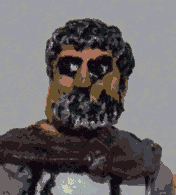
Know what I say - "Bad workmen always blame their tools". In this case, I reckon that's 100% correct - but the real "tool" was the one in the big hat commanding the army!
If you need to beat light troops to win the game, you need an army and a plan to beat them - no point taking on the heavy brigade, as all units count the same for army demoralization in these rules, don't they.
You might say that you had some bad match-ups. But in a Roman Era period, you should have expected to fight cataphracts a few times. However, irrespective of all this, a good general has a plan to beat whatever is put in front of him - and your plan was only good enough to beat part of what was put in front of you.
If I was asked to invest in your generalship, I'd have to say "I'm out!"
Lets hope you improve next time...!!
Learnt anything from this? Want a new army as a result ?
Click here to check out the UK eBay Ancients listings or here to look at the US listings and see what bargains you can get.
back to Madaxeman.com Home Page !
The Ancient Army List Index
The Rise of Rome (280 BC to 25 BC) Mid Republican Roman ; Late Republican Roman ; Gallic ; Pyrrhic ; Later Carthaginian ; Ancient Spanish ; Later Macedonian ; Later Seleucid ; Later Ptolemaic ; Attalid Pergamene ; Numidian or early Moorish ; Pontic ; Early Armenian ; Parthian ; Later Jewish ; Illyrian ; Spartacus Slave Revolt ; Bosporan ;
Storm of Arrows - Western Europe in the Later Middle Ages (1300 AD to 1500 AD) Medieval French ; 100-yrs War English (Continental) ; 100-yrs War English (Britain) ; Later Medieval Scots ( Britain) ; Later Medieval Scots (Continental) ; Later Scots Isles & Highlands ; Medieval Welsh ; Later Anglo-Irish ; Medieval Irish ; Low Countries ; Later Medieval German ; Italian Condotta ; Swiss ; Free Company ; Medieval Burgundian ; Medieval Danish ; Medieval Swedish ; Medieval Castilian ; Medieval Crown of Aragon ; Medieval Portugese ; Later Granadine ; Navarrese ; Ordonnance French ; Wars of the Roses English ; Ordonnance Burgundian ; Santa Hermandad Nueva Castilian
Immortal Fire - The Greek, Persian & Macedonian Wars (550 BC - 146 BC)
Classical Greek ;
Early Achaemenid Persian ;
Lydian ;
Thracian ;
Syracusan ;
Early Carthaginian ;
Skythian or Saka ;
Kyrenean Greek ;
Late Dynastic Egyptian ;
Alexandrian Macedonian ;
Later Achaemenid Persian ;
Classical Indian ;
Early Successor ;
Early Sarmatian ;
Galatian ;
Hellenistic Greek ;
Graeco-Bactrian ;
Graeco-Indian ;
Indo-Greek :
Legions Triumphant - Imperial Rome (25 BC to 493 AD) Dominate Roman ; Principate Roman ; Foederate Roman ; Later Sarmatian ; Early German ; Dacian or Carpi ; Ancient British ; Caledonian ; Early Alan ; Jewish Revolt ; Sassanid Persian ; Kushan or Indo-Skythian ; Palmyran ; Early Frankish, Alamanni, Burgundi, Limigantes, Rugian, Suevi or Turcilingi ; Western Hunnic ; Early Visigothic & Early Vandal ; Early Ostrogothic, Herul, Sciri or Taifali ; Early Anglo-Saxon, Bavarian, Frisian, Old Saxon or Thuringian ; Gepid or Early Lombard ; Early Scots Irish ; Early Pictish ; Hephthalite Hunnic ;
Swords & Scimitars - The Crusades (1096 AD to 1311 AD) Early Crusader ; Later Crusader ; Fatimid Egyptian ; Georgian ; Seljuk Turk ; Cuman ; Komnenan Byzantine ; Post Latin Conquest Byzantine ; Ilkhanid Mongol ; Mamluk Egyptian ; Cilician Armenian ; Syrian States ; Khwarazmian ; Ayyubid Egyptian ; Middle Serbian ; Middle Bulgarian ; Medieval Cypriot ; Latin Greece ; Pecheneg ;
Eternal Empire - Eastern Europe and the Rise of the Ottomans (1300 AD to 1500 AD) Early Ottoman Turkish ; Later Ottoman Turkish ; Tatar ; Later Russian ; Later Serbian Empire ; Later Bulgarian ; Later Lithuanian ; Later Polish ; Later Teutonic Knights ; Catalan Company ; Middle Hungarian ; Moldavian or Wallachian ; Albanian ; Timurid, White Sheep Turcoman or Black Sheep Turcoman ; Later Hungarian ; Hussite ;
Decline & Fall - Byzantium and Islam (493 AD to 1071 AD) Early Byzantine; Maurikian Byzantine ; Thematic Byzantine ; Nikephorian Byzantine ; Later Moorish ; Later Visigothic ; African Vandal ; Italian Ostrogothic ; Early South Slav ; Lombard ; Avar ; Arab Conquest ; Early Bulgar ; Ummayad Arab ; Abbasid Arab ; Early North African Dynasties ; Khurasanian Dynasties ; Bedouin Dynasties ; Dailami Dynasties ; Pecheneg ; Ghaznavid ; Western Turkish (includes Khazar);
Wolves From The Sea - The Hairy European Dark Ages Post Roman British ; Early Welsh ; Later Scots Irish ; Merovingian Frankish ; Later Pictish ; Early Slavic ; Middle Anglo Saxon ; Astur Leonese ; Andalusian ; Early Navarrese ; Carolingian Frankish ; Viking ; Magyar ; Great Moravian ; Early Scots ; Rus ; Norse Irish ; Early Medieval French ; Early Medieval German ; Norman ; Early Polish ; Anglo Danish ;
Swifter Than Eagles - The Biblical Book Nubian ; Early Libyan ; Later Sumerian or Akkadian ; Early Nomad Allies ; Old or Middle Kingdom Egyptian ; Hyksos ; Mitanni ; Syro-Canaanite ; New Kingdom Egyptian ; Later Minoan or Early Mycenaean ; Hittite Empire ; ; Middle or Early Neo-Assyrian ; Later Mycenaean or Trojan ; Sea Peoples ; Philistine ; Phoenician Allies ; Neo-Hittite And Aramaean ; Later Hebrew ; Mannaean Allies ; Libyan Egyptian ; Urartian ; Median ; Neo-Elamite ; Proto-Arab Allies ; Cimmerian or Early Skythian ; Neo-Assyrian Empire ; Phrygian Allies ; Kushite Egyptian ; Neo-Babylonian Empire ;
Oaf of Fealty - Early Medieval Europe Feudal Catalan and Early Crown Of Aragon ; Early Hungarian ; Taifa Andalusian ; Feudal Navarrese and Aragonese ; Feudal Castilian Leonese or Portuguese ; Fanatic Berber ; Italo-Norman ; Feudal French ; Imperial German ; Feudal German ; Communal Italian ; Papal Italian ; Early Scots Isles And Highlands ; Feudal Scots ; Early Russian ; Feudal Polish ; Anglo-Norman ; Later Welsh ; Early Lithuanian or Samogitian ; Wendish Prussian or Estonian ; Early Medieval Frisia and Other Free Cantons ; Post-Viking Scandinavian ; Early Plantagenet English ; Later Sicilian ; Early Medieval Irish ; Early Anglo-Irish ; Early Teutonic Knights ; Mongol Invasion ; Early Granadine ; Middle Plantagenet English ;
Empires of The Dragon - China, Korea and Japan Erlitou-Shang Chinese ; Early Northern Barbarian Allies ; Early Zhou Chinese ; Yayoi Japanese ; Early Horse Nomad ; Ko Choson Korean ; Warring States To Western Han Chinese ; Qiang And Di ; Three Kingdoms Korean ; Eastern Han Chinese? ; Three Kingdoms W Jin And S Dynasties Chinese ; Kofun Nara Japanese ; Northern Dynasties Chinese ; Later Hindu North Indian ; Later Hindu South Indian ; Central Asian City States ; Western Wei To Early Tang Chinese ; ; Later Horse Nomad ; Tibetan ; Nepalese Allies ; Parhae Korean ; Late Tang To Five Dynasties Chinese ; Khmer Or Champa ; Thai Allies ; Nanzhao ; Pyu Burmese Allies ; Koryo Korean ; Early Heian Japanese ; Pagan Burmese ; Liao ; Song Chinese ; Xi Xia ; Ghurid Afghan ; Jin ; Late Heian To Muromachi Japanese ; Japanese Warrior Monk Allies ; Mongol Conquest ; Moslem Indian Sultanates ; Medieval Indonesian Or Malay ; Yuan Chinese ; Medieval Burmese ; Ming Chinese ; Yi Korean
Blood and Gold - The Americas Olmec ; Teotihuacan ; West Mexican ; Zapotec or Mixtec ; Toltec ; Chinantec ; Aztec ; Tarascan ; Tlaxcalan Confederacy ; Mayan ; Mochica ; Chanca ; Chimu ; Hatun-Colla ; Canari ; Inca ; Mapuche or Araucanian ; Amazonian Forest Tribes ; Tupi ; Chichimec ; Pueblo Culture ; Mound-Builder Culture ; South-Eastern Woodland Culture ; Timucuan ; Eastern Woodland Culture ; Plains Culture ; Pacific North-West Culture
View My Stats for My FoG Pages


